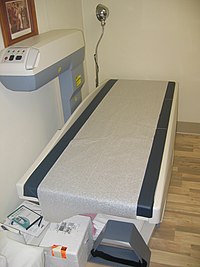
Photo from wikipedia
Low muscle mass, strength (dynamometry), and power (five times sit-to-stand tests), alone or in combination (ie, sarcopenia), are associated with low areal bone mineral density, impaired bone geometry, and, as… Click to show full abstract
Low muscle mass, strength (dynamometry), and power (five times sit-to-stand tests), alone or in combination (ie, sarcopenia), are associated with low areal bone mineral density, impaired bone geometry, and, as a consequence, of low bone strength in postmenopausal women. These measures may assist in identifying and preventing postmenopausal women at risk for hip fractures. Abstract Objective The aim of this study was to verify whether sarcopenia and its components are associated with hip areal bone mineral density (aBMD) and geometry in postmenopausal women (PW). Methods In this cross-sectional study, appendicular bone-free lean mass (aLM) and hip bone mass and geometry were measured using dual-energy x-ray emission absorptiometry (DXA). Muscle power and strength were measured by five times Sit-to-Stand Test (5-STS) and dynamometry, respectively, in 175 PW. Sarcopenia was identified as low aLM plus low muscle strength or low muscle power. Multiple linear regression (covaried by age, smoking, hormonal therapy, and diseases) was used to determine the relationship between sarcopenia and bone geometry and mass. The results are presented as mean differences between groups. Results Dynamometry, five times Sit-to-Stand Test, and aLM indicated positive associations (P < 0.05) with most indicators of bone mass and geometry. Sarcopenia, applying low muscle strength or low muscle power, was negatively associated with femoral neck width (−0.2 mm, P = 0.001), cortical thickness of femoral calcar (−0.6 mm, P = 0.043), subtrochanteric cortical thickness (−1.2 mm, P = 0.002), femoral neck cross-sectional area (−19.5 mm2, P < 0.001), cross-section moment of inertia (−2,244 mm4, P < 0.001), section modulus (−115 mm3, P < 0.001), femoral neck aBMD (−0.1 g/cm2, P = 0.002), upper femoral neck aBMD (−0.1 g/cm2, P = 0.003), lower femoral neck aBMD (−0.1 g/cm2, P = 0.016), and trochanteric aBMD (−0.1 g/cm2, P = 0.035). Conclusions Thus, muscle mass, strength and power, alone or in combination (ie, sarcopenia), are associated with low aBMD, impaired bone geometry, and, therefore, bone strength in PW. These measures may help identify PW at risk of hip fractures.
Journal Title: Menopause
Year Published: 2022
Link to full text (if available)
Share on Social Media: Sign Up to like & get
recommendations!